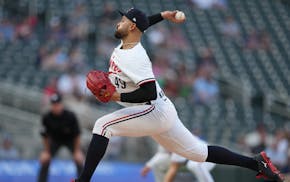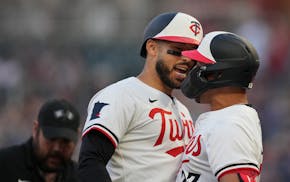The Big Ten used this year's additions of Rutgers and Maryland to restructure its football divisions, replacing the often-mocked Leaders and Legends titles with East and West.
Critics generally applauded the announced changes in April 2013, but the divisions appeared unbalanced. On paper, 16 months ago, the East looked considerably stronger than the West.
But that was before Iowa and Nebraska knocked off a reeling Michigan program last fall. That was before the Gophers and Nebraska defeated a Penn State squad still reeling from the Jerry Sandusky scandal. And that was before quarterback Braxton Miller suffered a season-ending shoulder injury, robbing Ohio State of the conference's most important player.
The East might have the Big Ten's best team, with Michigan State, but the West should have the best race with Wisconsin, Iowa, Nebraska, Northwestern, and yes, even the Gophers, believing they have a chance to reach Indianapolis for the conference title game.
"I think these things ebb and flow," Big Ten Commissioner Jim Delany said in July. "Northwestern has been to a Rose Bowl. Wisconsin went to three or four in a row. Nebraska has won national championships. Iowa has played in very big games. Illinois has played in Rose Bowls and other major bowls.
"When I think about historic balance, I think that the teams will play out based on the quality of the players and quality of the coaches. And I'm not worried about that part of it."
The Big Ten introduced a conference championship game in 2011, and Wisconsin won the first two. Michigan State knocked off Ohio State last year, playing a physical style similar to what Wisconsin, Iowa and Minnesota use, with an emphasis on defense and time of possession. Nebraska once perfected that style under Tom Osborne.
"The blue bloods [Ohio State, Michigan, Penn State] haven't won a championship game yet, and the three teams that have won the championship all look like Neanderthal football," Iowa coach Kirk Ferentz said. "At least that's what people want to call it. To me, it's good football. They don't turn it over, they run it, they pass it, and they score enough points to win and play defense. That's what the game has always been about."
Maybe that will be the West's identity — Neanderthal football.
Wisconsin looks ready for it, at least offensively, with Melvin Gordon and Corey Clement running behind a veteran offensive line. Gordon would have been one of the top running backs picked in the NFL draft but returned for his junior season, knowing he'll get the bulk of the carries now that James White has graduated.
Badgers second-year coach Gary Andersen is ready to mix things up a bit, though, by picking Tanner McEvoy as the starting quarterback over Joel Stave. The 6-6 McEvoy is a dual-threat QB who overcame a wrist injury last year and wound up starting three games — at safety.
"I would say he's an elite athlete," Andersen said. "It allows you to do some things offensively to force defenses to understand that if you make a mistake, he's more than willing to take off and make you pay."
The bigger question for the Badgers is defense, where they need to replace eight starters, including standout middle linebacker Chris Borland. Defensive coordinator Dave Aranda and his 3-4 system will get tested immediately, as Wisconsin opens Saturday against LSU in Houston.
Iowa needs to replace a trio of linebackers that started together for two years — James Morris, Christian Kirksey and Anthony Hitchens. But the Hawkeyes should be tough in the trenches again, with experience returning on both lines, including left tackle Brandon Scherff, a likely first-round NFL draft pick who returned for his senior season.
"I think [the West] is wide open," Iowa running back Mark Weisman said. "I definitely think it has a lot of physical teams, and that's what we pride ourselves on."
Wisconsin and Iowa were picked first and second in the West, respectively, in Cleveland.com's annual Big Ten sportswriters' poll. Those teams were followed by Nebraska and Northwestern, two teams that took several roster hits during training camp.
Nebraska has two potential first-team All-Americas in running back Ameer Abdullah and defensive end Randy Gregory. But during fall camp, the Huskers suffered season-ending injuries to linebacker Michael Rose, defensive back Charles Jackson and backup running back Adam Taylor. In addition, safety LeRoy Alexander was suspended for the season.
Northwestern thought it had exhausted its bad luck last year, but versatile running back Venric Mark transferred after getting suspended for the first two games. Wide receiver Christian Jones (knee) and defensive tackle Sean McEvilly (foot) also suffered season-ending injuries in August.
One main challenge for the Gophers is the schedule. Each team plays two interdivision games against the Big Ten East. Minnesota drew Michigan and Ohio State, while Wisconsin gets Maryland and Rutgers, and Iowa gets Indiana and Maryland.
"I think there's a philosophy to that," coach Jerry Kill said. "I won't share that with you, but I've got a pretty good idea after looking at the schedule, who got what, when."
Though Kill wouldn't say it, others have noted that the Big Ten schedule-makers gave many of its perennial contenders softer conference schedules, knowing that might help their chances of reaching the new four-team College Football Playoff.
Each conference game counts the same in the standings, even though a 7-1 Gophers finish would be more impressive than a 7-1 finish for the Badgers or Hawkeyes.
"There's nothing you can do about it," Kill said. "And the great thing about that is if you win a couple [interdivision games] like that, you're going to be playing [in] a pretty good situation."
Twins get ahead of Orioles and stay there, winning again amid a Buxton power surge
Frost suffer playoff loss at Toronto in defense of their PWHL championship

Twins' López wields a new tool for taking on lefthanded batters: a second changeup

Neal: As Correa searches for his swing, Twins watch for signs of the hitter they thought they hired

